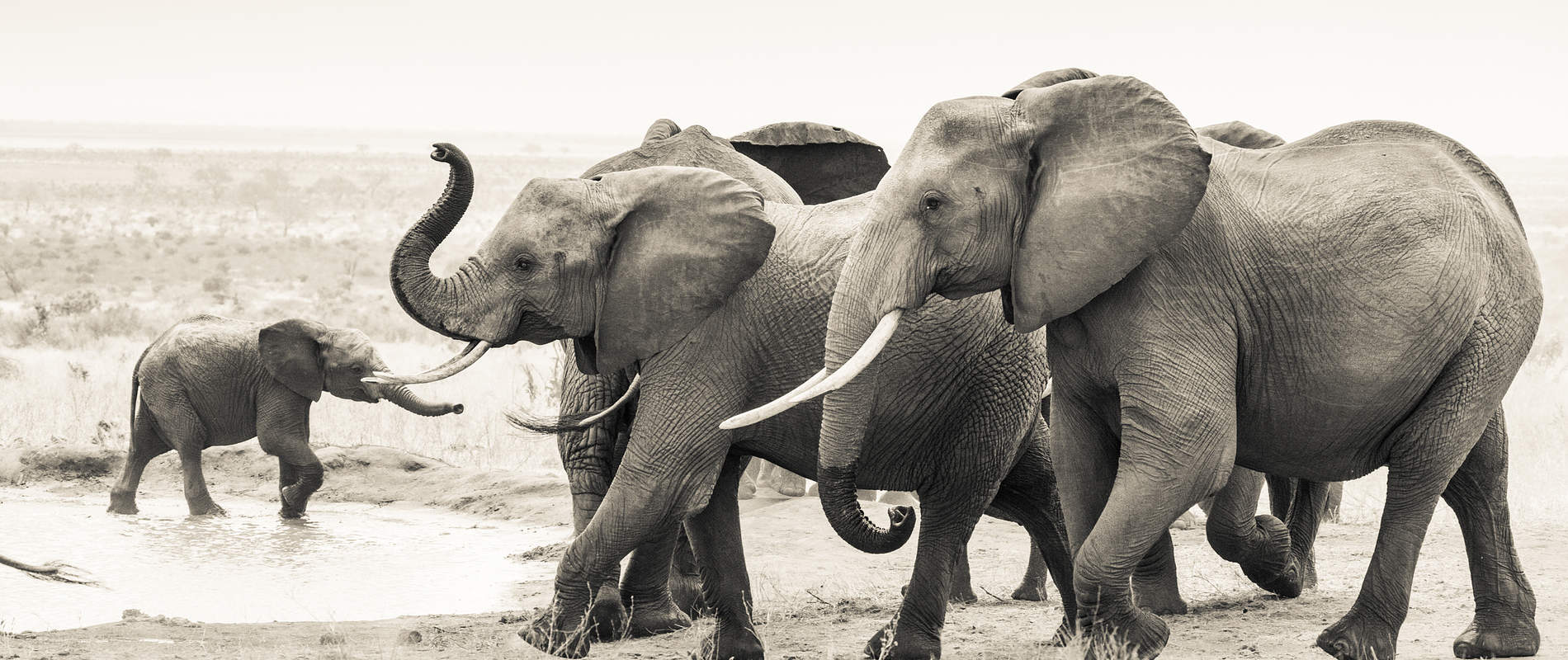We always welcome stories that warm the heart and raise spirits. But now, when hope is at a premium, we need them more than ever.
This month’s Field Notes begins as a tragedy, but ends on a triumphant note. I hope its contents serve as a moonbeam of optimism for you, as they do for me.
- Angela Sheldrick

The Tragedy and Triumph of Kenya's Elephants
To begin, we must go back in time. At the turn of the twentieth century, Africa was home to about 12 million elephants. Today, some 400,000 roam the continent. In other words, over the course of a century, 97 percent of these revered creatures disappeared from the earth.
(I know that I promised a story of hope and I assure you that, ultimately, this is one. Stay with me!)
Human greed is at the root of this decline. The rise of trophy hunting put the species under strain, but the international appetite for ivory trinkets proved cataclysmic. It was a slow burn until the late 1970s, when poaching reached frenzied levels. In 1969, uncarved ivory was worth $2.50 per pound. By 1978, demand had driven the price up to $34 per pound. In a single decade, Africa lost half its elephants to the ivory trade.

Herds of this size were a common sight up until the 1970s
This was a sobering wake up call. In July 1989, when Kenya’s elephant population had dwindled to just 16,000, then-President Daniel arap Moi burned 12 tonnes of ivory to bring global attention to the poaching crisis. More than just an emblematic inferno, this was also a compelling call to action: Three months later, the international commercial ivory trade was effectively banned under the Convention on International Trade in Endangered Species (CITES).
Over the next several years, elephant populations began to recover. However, as we embarked on the new millennium, poaching remained a dormant threat. Driven by a renewed desire for ivory objects in the East, a second wave of poaching began in force. Between 2010 and 2012, one elephant was killed every 15 minutes for its ivory. This was a harrowing time for the species, as indicated by the influx of orphans we rescued during the three-year period. Some were found standing vigil beside their dying mothers (Araba, Barsilinga, Quanza, and Zongoloni stand out as four heartbreaking examples). More often than not, however, the calves were discovered completely alone, witness to untold tragedies.

Newborn Quanza with her mother, Qumquat, and sisters, Quaye and Quantina. Just a few months later, she would lose her entire family to poachers. (Photo © Amboseli Trust for Elephants)
As the global community rallied around elephants, we took swift action here in Kenya. Working in partnership with the KWS, we ramped up our work in the field. We expanded our anti-poaching operations, bringing on a Canine Unit and growing our fleet of aircraft to bolster patrols on the ground and in the air. We doubled our Mobile Veterinary Units, so we could quickly respond to wildlife emergencies. Crucially, we also secured vast tracts of wilderness, creating safe havens for elephants and other creatures.

Araba, and other orphaned elephants who suffered a similar fate, will eventually reclaim their place in the wild.
And now, we reach the uplifting portion of our story: These measures worked. Thanks to a concerted effort by many, Kenya's elephant population has more than doubled in the past 30 years, to 34,000. As history has shown us, we cannot afford to be complacent about poaching, and there are other looming threats on the rise, such as habitat loss and human-wildlife conflict. However, because of dedicated conservation efforts, tuskers can continue their lineage, mothers can carry to term, calves can grow up in the wild, and the entire species has hope for a future.

Every elephant baby is cause for celebration.
Just last week, we were privileged to meet one of Kenya’s newest elephants, a wild baby born to Lenana, an orphan whom we rescued in 2006. Lenana’s personal story is one of tragedy and triumph: She was little more than a year old when she was found desperately trying to rouse her dead mother, who had succumbed to a mysterious illness. That experience haunted her, and she arrived at the Nursery terrified and grief-stricken. Time eventually healed her psychological wounds, and Lenana poured her heart into caring for others, first at the Nursery, then at our Ithumba Reintegration Unit, and most recently as a wild elephant. When fellow ex orphans Galana, Lualeni, and Kinna became mothers, she was their chosen nanny. And so, we were absolutely delighted when it became clear that she too was destined for motherhood. Lenana could not wait to celebrate her joy with the people who raised her; her baby was still wobbly on his legs when she shepherded him to our Ithumba stockades on the evening of August 22nd!

Lapa, one of Kenya's newest elephants. His name means "moon" in Samburu, a symbol of hope.
We are calling Lenana’s calf Lapa, which means “moon” in Samburu. This seems a most fitting name for these times. During even the darkest nights, the moon serves as a light, as a beacon of hope. Humans may present the gravest threat to the survival of elephants, but we can also be part of the solution. For every life we save has a ripple effect, paving the way for future generations, and ensuring that we never know a world without elephants.
Angela Sheldrick produces Field Notes as a special monthly email, providing her personal insight into varying aspects of Kenya's wildlife and habitats, along with the work of the Sheldrick Wildlife Trust. To be the first to receive future editions of Field Notes, please subscribe here.
